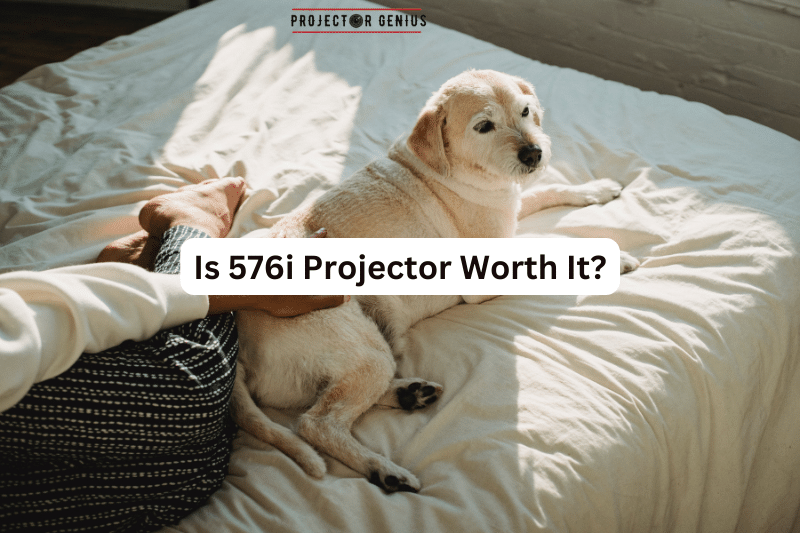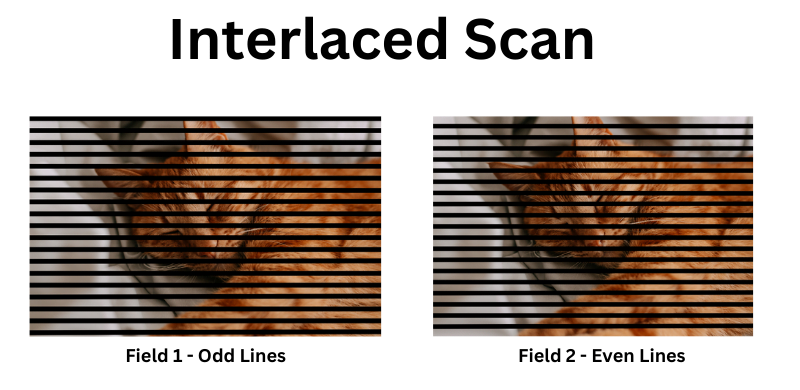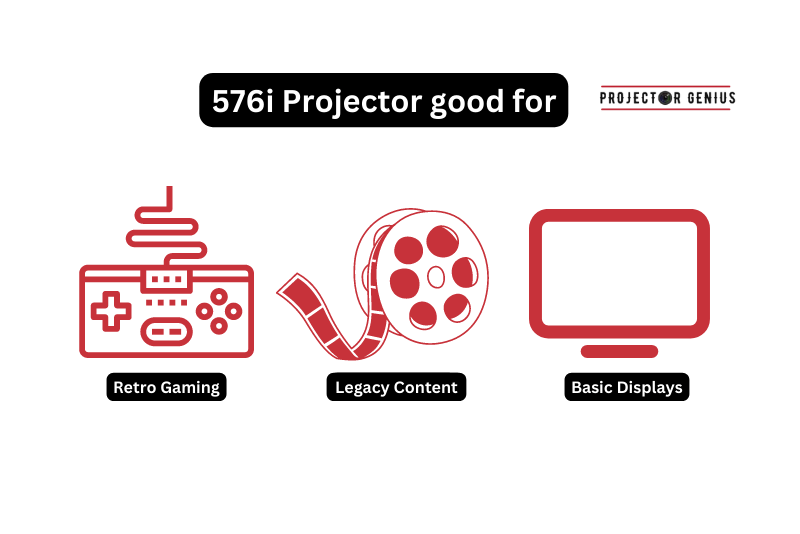Is 576i Projector Worth It?
-
 Written by:
Kristy Roger
Written by:
Kristy Roger
- Last Updated:
So you are wondering if 576i Projector is Worth It! And you’ve come to the right place.
Choosing the best is difficult, I know! Fortunately, I’ve spent several years researching and studying projector video production and have managed to narrow it down for you.
During this time, I’ve had hands-on experience with hundreds of different projector types. Let’s dive into the pros and cons to help you decide: Is 576i Projector Worth It?
I’ll also help you decide which Resolution works best for you. If budget isn’t a concern, you can explore a comparison between 1080p and 2K resolutions.
Is 576i Projector Worth It? A 576i projector can be worthwhile for specific needs, like retro gaming or displaying older content. However, for modern HD or 4K content, it may not provide the best visual experience, as it’s lower in resolution compared to more contemporary projectors.

I recommend using the Table of Contents to quickly access the information you need.
My article is designed to cater to home cinema users of all levels, from Beginners to Advanced enthusiasts.
Table of Contents
What is a 576i projector?
A 576i projector refers to a type of display equipment that operates at a specific resolution known as 576i, where “i” stands for interlaced. This resolution is characterized by a pixel count of 720×576. The interlaced aspect means that the image is constructed by drawing every other line of the frame in one pass, followed by filling in the remaining lines in the next pass. This method of image rendering was common in older television systems.

In terms of characteristics, a 576i projector presents images with 720×576 pixels, which is a relatively lower resolution compared to modern high-definition formats like 720p or 1080p. This results in a less detailed and slightly less sharp image quality.
Historically, 576i projectors were prevalent during the era of standard-definition television. They were widely used in regions and applications where this resolution was the standard for broadcasting and video playback. However, with the advent of high-definition technology, projectors with higher resolutions have become more common, offering significantly crisper and more detailed images. Therefore, while 576i projectors have historical significance, they are less commonly used in modern settings where higher resolutions are preferred for enhanced visual quality.

What type of Content is Suitable for a 576i Projector?
A 576i projector is best suited for specific types of content due to its resolution limitations. When considering what content is suitable, it’s important to take into account several key factors.
Available Content: One of the primary considerations is the type of content you plan to display. 576i projectors are most compatible with standard-definition content. This includes older movies, TV shows, and videos produced before the widespread adoption of high-definition formats.
Intended Use: Consider the purpose for which you’re using the projector. If it’s for casual viewing of older content or presentations that don’t require high-resolution visuals, a 576i projector might suffice. However, if you’re looking to showcase high-definition media or require precise, detailed visuals, a higher-resolution projector would be more suitable.
Budget: Budget constraints play a significant role in the selection process. 576i projectors are generally more affordable compared to their higher-resolution counterparts. If cost is a primary concern, a 576i projector could be a cost-effective solution.
Viewing Environment: Consider the physical space in which the projector will be used. If the room is small or has limited screen size, the lower resolution of a 576i projector may not be as noticeable. However, in larger spaces or when projecting onto larger screens, the limitations of 576i resolution may become more apparent.
Compatibility with Source Devices: Ensure that your source devices (such as DVD players, gaming consoles, or laptops) are compatible with a 576i signal. Some newer devices may primarily output higher-resolution content, which could result in a mismatch with the projector.
Future-Proofing: Consider your long-term needs. If you anticipate using the projector for years to come, it may be worth investing in a higher-resolution model to ensure compatibility with evolving media standards.
Overall, when evaluating a 576i projector, it’s crucial to weigh factors such as available content, intended use, budget constraints, the viewing environment, compatibility with source devices, and long-term usage plans. This comprehensive assessment will help determine whether a 576i projector is the right choice for your specific needs and circumstances.
How does 576i Resolution Compare to HD and Other Standards?
Let’s talk about how 576i resolution stacks up against more common standards like HD and 4K.
576i, to put it plainly, falls on the lower end of the resolution scale. When compared to HD, which stands for high-definition, the difference is quite noticeable. HD provides much sharper and clearer images because it has more pixels on the screen. With 720p or 1080p HD resolutions, you’re looking at anywhere from two to six times more pixels than 576i. This means finer details are much more distinct.
Now, when we step up to 4K, the contrast is even starker. 4K resolution boasts a whopping four times the number of pixels as HD. This means the level of detail is incredibly high. When you watch something in 4K, it’s like having a super sharp, vivid image right in front of you.
In terms of image quality, 576i can sometimes look a bit fuzzy or less defined, especially on larger screens. The edges of objects might not be as crisp, and you might notice some jagged lines. It’s a bit like comparing a photograph taken with a regular camera to one taken with a high-end professional camera.
The visual experience is where the real divergence shines through. With HD and 4K, you’re getting a more immersive, lifelike experience. Colors are more vibrant, and everything just pops off the screen. It’s like looking through a clear window. 576i, on the other hand, can feel a bit dated in comparison. It’s perfectly serviceable for older content, but it might not do justice to the visual feast that newer, high-definition media can offer.
Are there Benefits to Using a 576i Projector in Modern Settings?
Yes, there can be some benefits to using a 576i projector in modern settings. Let’s take a closer look at the pros and cons.
On the positive side, one clear advantage is cost. 576i projectors tend to be more budget-friendly compared to higher-resolution models. This makes them an attractive option for those looking to set up a basic home theater or for businesses on a tight budget.
Another advantage is compatibility with older content. If you have a collection of DVDs, VHS tapes, or older video game consoles, a 576i projector can be a great choice. It’s tailored for standard-definition content, ensuring that older media formats look their best.
Additionally, there’s a certain nostalgia associated with 576i. It can evoke memories of the earlier days of television and cinema. For some, this nostalgic quality adds a special charm to the viewing experience, creating a unique atmosphere that higher resolutions might not capture.
However, it’s important to consider the drawbacks. The most significant is the lower image quality. In comparison to HD or 4K projectors, 576i may appear less sharp and detailed. This can be especially noticeable on larger screens or in rooms with higher ambient light.
Furthermore, 576i projectors may not be as versatile for modern high-definition content. If you primarily consume newer movies, games, or streaming services, you may not get the full visual experience that these formats offer.
In summary, choosing a 576i projector in a modern setting has its merits, particularly in terms of cost, compatibility with older content, and the nostalgic feel it can bring. However, it’s essential to weigh these benefits against the potential drawbacks, especially if you prioritize high-quality visuals for modern media. Ultimately, the decision comes down to your specific preferences and viewing needs.
Can I Upscale Content for Better Quality on a 576i Projector?
Yes, it is possible to upscale content for better quality on a 576i projector. Upscaling involves taking a lower-resolution video signal and adjusting it to fit the native resolution of the projector, in this case, 576i.
There are devices known as upscalers or video processors that can perform this task. These devices take the incoming signal and use algorithms to interpolate additional pixels, effectively enhancing the image to fit the higher resolution. Keep in mind, however, that while upscaling can improve the visual appearance, it won’t match the clarity of true high-definition content.
It’s worth noting that the effectiveness of upscaling depends on the quality of the upscaling device and the original content. Some upscalers do a better job than others, and certain types of content may upscale more successfully than others.
Is 576i Projector Worth It?
Deciding if a 576i projector is worth it boils down to considering various factors.
Firstly, if you have a collection of older movies or classic video games, a 576i projector can be a fitting choice. It excels at displaying content originally designed for standard-definition formats. The visuals may not be as sharp as high-definition, but they still capture the nostalgic charm of earlier media.
Budget is another significant aspect. 576i projectors are generally more budget-friendly compared to their higher-resolution counterparts. If you’re working within financial constraints, opting for a 576i projector allows you to set up a basic home theater without breaking the bank.
However, it’s crucial to consider the nature of your viewing experience. If you have a larger viewing area or plan to use the projector for presentations, the limitations of 576i resolution may become more apparent. In such scenarios, a higher-resolution projector would provide a clearer, more defined image.
Additionally, future-proofing is worth thinking about. If you foresee a shift towards higher-definition content in your media consumption habits, investing in a higher-resolution projector might be a more prudent long-term choice. It ensures your equipment remains compatible with evolving media standards.
In conclusion, the worthiness of a 576i projector hinges on your individual preferences, budget, viewing environment, and future usage plans. If you have a fondness for older content and are mindful of your budget, a 576i projector can offer a satisfactory viewing experience. However, if you prioritize top-notch visuals for modern high-definition content, a higher-resolution projector may be a more suitable investment. It’s essential to carefully assess your specific needs before making a decision.
FAQs (Frequently Asked Questions)
Is a 576i Projector a Cost-Effective Choice?
Yes, a 576i projector can be a cost-effective choice, depending on your specific needs and budget constraints. These projectors are generally more affordable compared to their higher-resolution counterparts. If you’re primarily interested in viewing older content like DVDs, VHS tapes, or older video game consoles, a 576i projector provides a suitable option without the need for a higher-priced high-definition model. This cost savings can be particularly appealing for individuals or organizations looking to set up a basic home theater or presentation system without breaking the bank.
However, it’s important to bear in mind that the cost-effectiveness of a 576i projector may be relative to the intended use. If you anticipate viewing a significant amount of modern high-definition content, investing in a higher-resolution projector may offer better value in the long run. Additionally, while a 576i projector may save money upfront, it’s important to consider potential trade-offs in terms of image quality and compatibility with newer media formats. So, while cost-effectiveness is a definite advantage, it’s crucial to weigh it against your specific viewing preferences and future needs.
Will a 576i Projector Become Obsolete in the Near Future?
Yes, it’s likely that a 576i projector will become somewhat obsolete in the near future. With the rapid advancements in display technology, higher resolutions like HD and 4K are becoming the standard for modern content. As a result, a 576i projector may struggle to keep up with the increasing demands for sharper, more detailed visuals. It may not provide the level of clarity and visual richness that viewers are coming to expect from their viewing experiences.
Furthermore, as content producers continue to shift towards high-definition formats, compatibility issues may arise for a 576i projector. Newer devices and media sources may not be optimized for this lower resolution, potentially limiting the range of content that can be effectively displayed. This could lead to a less satisfying viewing experience, making it less practical for those who value high-quality visuals in their entertainment or presentations. So, while a 576i projector may still have its niche uses, it’s likely to face growing limitations in the rapidly evolving landscape of display technology.
Final Thoughts
A 576i projector serves its purpose in specific contexts, particularly for those with a preference for older content formats like DVDs and VHS tapes. Its affordability makes it an attractive option for budget-conscious individuals or organizations seeking to set up a basic home theater or presentation system. Additionally, the nostalgic charm associated with 576i can add a unique dimension to the viewing experience, evoking memories of earlier days in television and cinema.
However, it’s important to acknowledge that as display technology advances, 576i projectors are gradually becoming less aligned with the expectations of modern viewers. With the widespread adoption of higher resolutions like HD and 4K, the limitations of 576i in terms of image quality and compatibility with newer media formats become more apparent. Therefore, for those who prioritize a premium viewing experience with high-definition content, investing in a higher-resolution projector may offer better value in the long run.
Author of this Post:

Kristy Roger
Home Cinema Consultant & Tech Enthusiast
Holding a background in Industrial and Electrical Technology from the University of Alberta, Kristy has spent 5+ years consulting on home theater products at a top electronics firm. As a certified Technical Professional with Lean Six Sigma credentials, Kristy expertise ranges from projector nuances to hands-on experience with leading models. Kristy have been sharing her knowledge online for two years, blending professional insights with personal experiences from her own home cinema setup. Off the screen, She is a dedicated mom to Jerry, Ryan, and our two pups, Cuddle and Paw.



